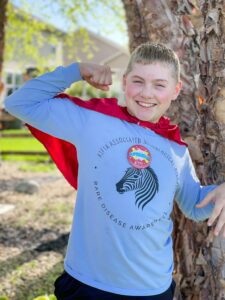
Rare Community Profiles is a Patient Worthy article series of long-form interviews featuring various stakeholders in the rare disease community, such as patients, their families, advocates, scientists, and more.
Superhero Liam Battles KAND with the Help of Shriners Children’s
We’re about to get off the Zoom call after our interview when 14-year-old Liam leans forward with a conspiratorial smile. Making eye contact with everyone left in the room – or at least making eye contact in the best way you can on video – Liam asked:
“Where did the hamburger go to dance? The meatball.”
Everyone on the call – Liam’s mother Melissa, father Jeff, and team members from Shriners Children’s – belly laughs in response. They tell me that, at the end of every meeting or phone call, Liam always offers a joke to end things on an uplifted note.
Outside of Zoom calls, Liam does his best to maintain that positivity daily. The seventh grader loves fishing, hunting, playing games, Marvel superheroes, and gardening, a skill that Melissa has not yet conquered. She tells me that she is hospice for plants. She always kills them, adds Liam:
“But I’ll save them.”
The more we speak, the more I see a pattern emerging: Liam’s humor and tenacity in the face of challenges. And he has faced his fair share. After all, Liam is one of just 550 known cases of KIF1A-associated neurological disorder (KAND) in the world.
He’s also the only one out of those 550 individuals with his specific variant. This means that the family is constantly traversing unexplored healthcare landscapes, learning along the way.

But they’re not alone in their fight for advocacy, awareness, and a deeper understanding of KAND. Shriners Children’s has been caring for Liam for over a decade. The team has been instrumental in advancing research into KAND. On a more personal level, says Melissa, Shriners Children’s has been equally instrumental in ensuring Liam’s high quality-of-life.
In our interview, the family spoke more about KAND, new research and developments, and how other families affected by KAND can find support.
Liam’s Story
In early infancy, Melissa and Jeff saw no issues with Liam’s development. He seemed to be a happy, healthy, bubbly baby. It wasn’t until his first birthday that concern began to set in. Liam was missing developmental milestones.
The family was referred to a specialist. This visit was unhelpful, to say the least. The physician could provide no diagnostic information; he only recommended that Liam start physical therapy.
As time progressed, Melissa and Jeff noticed other signs that something was going on under the surface with their son. Liam began toe-walking. He had no balance; anywhere the family went, they knew he’d topple and fall over. Melissa also noticed Liam’s muscle rigidity. Yet physicians kept pushing the family away with no answers.
By the time Liam was five years old, Melissa and Jeff were desperate for answers. Their local Boston hospital tested Liam for cerebral palsy (CP) but, once again, the MRI came back with no clues. At this point, says Melissa:
“We were frustrated, confused, and lost. Liam was still falling. We took a chance and went to Shriners in Boston, which is a burn hospital. They connected us with Dr. Gleeson Rebello, an orthopedist at Mass General, but also wanted to stay on with Liam.”
This ended up being the breakthrough that the family needed. Dr. Rebello collaborated with multiple physicians – “12 neurologists,” Liam interjects – who wracked their brains for answers. Eventually, one physician recommended a genetic test. And Liam’s life changed forever.
Reaching the Diagnosis
KIF1A. When the family received the diagnosis, they were blown away. They finally had the answer, right in front of them. A mutation in Liam’s KIF1A gene was causing his symptoms.
What they didn’t know, at the time, was how much there still was to learn about KIF1A-associated neurological disorder.
As soon as the test results came back, a doctor called the family. Melissa remembers the words ringing through her head as clear as a bell:
“She said to us, ‘If you look it up, it’s scary. But we don’t know what’ll happen yet. So don’t go by what you find on the Internet.’ At the time, Liam was the second person to have gotten this diagnosis. There was nothing to go by.”
Four days later, after the family moved to North Carolina, they were referred to a doctor at Duke University Medical Center. Unfortunately, shares Melissa, the doctor was disinterested in taking Liam’s case:
“One of the most frustrating things is that nobody knew what KIF1A was or how to treat it, so most doctors didn’t want to work with us and figure things out. We heard, ‘Just come back in six months and we’ll see if anything changed.’ As a parent, it was terrible. I felt shunned. I felt alone. I watched my kid struggle and fall and didn’t know how to help him. It was also frustrating as a parent without a medical background to see doctors’ disinterest. In my mind, doctors are there to help. So it was disappointing, but very exciting when we got back to Shriners to the right people and the right doctors.”
Motivated by the help she originally received at Shriners, Melissa called the Shriners in Greenville, SC. She connected with Dr. Lauren Hyer, who didn’t know much about KIF1A but was ready to learn. Dr. Hyer tracked Liam’s gait, mobility, and more; she planned the necessary surgical interventions. Liam began twice-weekly physical therapy in Greenville.

When the family moved to Ohio, they once again sought out Shriners (the Lexington campus). At this point, says Melissa:
“Liam has been treated at three Shriners locations and has been an ambassador for two locations. I genuinely believe that Shriners played a critical role in forging Liam’s path. He no longer toe walks, doesn’t fall as often, and is nowhere near as stiff as he used to be.”
About KIF1A-Associated Neurological Disorder (KAND)
Also known as: KIF1A related disorder
KIF1A-associated neurological disorder refers to a group of rare neurodegenerative disorders caused by KIF1A mutations. Normally, this gene produces a protein that plays a role in different bodily processes. Many individuals with KAND have different genetic mutations. As a result, KAND manifests in various ways. As Melissa shares:
“For Liam, it appears in his lower extremities and his cognitive abilities. His muscles are very tight. He must constantly work on stretching and has had several muscle-related surgeries, as well as metal rods in his legs. This has helped him improve his mobility.”
To help manage his muscle tightness and mobility, Liam works closely with Shawn, his physical therapist. With a groan – letting everyone know that he does not enjoy his stretching routine – Liam says:
“Shawn is my friend, and he’s a funny person some days. We do calf stretches, leg lifts, kneeling – ugh, kneeling! – and floor workouts. Shawn makes it fun because we can play games like Jenga and Uno while we do the routines.”
For others with KAND, symptoms may present at birth or in early childhood as:
- Gait abnormalities
- Muscle spasticity
- Intellectual disability
- Developmental delays
- Optic nerve atrophy (and associated vision loss)
- Tremors
- Crossed eyes (strabismus)
- Peripheral neuropathy
- Hypotonia (low/floppy muscle tone)
- Flat feet
- Difficulty eating or swallowing
- Epilepsy
For a comprehensive list of symptoms, as well as additional information and support resources, head to KIF1A.org.
KAND Research
Dr. Wendy Chung of the Chung Lab at Boston Children’s is currently working to better understand KAND through the ASCEND Natural History Study and KOALA Study. The ASCEND Study connects with and follows people with KAND over time to learn more about the disease progression and phenotypes. In the KOALA study, researchers will determine how KAND symptoms develop and change over time. This provides outcome measures and endpoints that can be used in future clinical studies.
Outside of these studies, Dr. Chung is interested in exploring the potential for CRISPR gene therapy interventions during pregnancy; Dr. Chung is also looking into how patients and families who cannot travel can submit brain MRIs and overnight EEG information for monitoring. Says Melissa:
“She’s the only person we can call and ask, ‘Okay, what’s next for KAND?’”
Why Parents Need to Be Advocates
As described above, KAND presents in many ways. The global KAND community is also small and very few reach adulthood. This makes it difficult for doctors to collaborate, share and compare ideas, and adequately reach – and treat – patients. By raising KAND awareness, Melissa, Jeff, and Liam hope to empower other families to advocate for themselves in the medical sphere. Says Melissa:
“It’s very important for families to push for answers with their doctors. I was timid until I decided that, for my son, I can’t be. So don’t be timid. Because doctors don’t know about KAND, it’s easy to say – ‘the symptoms go with this, so we’re going to go with this.’ That’s why we’re finding now that many patients with KAND were originally diagnosed with cerebral palsy or ataxia. You need to ask for genetic testing. If we didn’t ask for that test, we would still be in the dark and lost. You know your child, so if something feels wrong, bring it up. And keep bringing it up until you find answers. Find a doctor that will learn with you because that can be such a monumental thing.”
Jeff agrees, telling parents to switch providers if they’re feeling frustrated or unheard:
“Find your voice. If you don’t like how you’re being treated, say something or find a different doctor. Don’t settle for disinterest or lack of knowledge. I also think, if you’re feeling stuck, you should lean into your support group. There are other families with KAND who are going through the same issues. KIF1A is a beast, but we’re learning alongside other families. Having that foundation lets you figure out the best choice for your child.”
As his parents work to tirelessly advocate for KAND awareness, Liam advocates too by sharing his stories, his triumphs, and his experiences. There are many misconceptions about rare disease and its impact on abilities. But Liam never lets these misconceptions get him down. Instead, he lives on with the grit and confidence of the very superheroes he loves, saying:
“KAND doesn’t keep me from life. I’m still very capable. I can still do hard things.”



